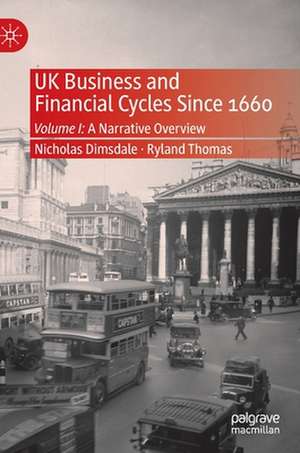UK Business and Financial Cycles Since 1660: Volume I: A Narrative Overview
Autor Nicholas Dimsdale, Ryland Thomasen Limba Engleză Hardback – 13 noi 2019
This book is the first of two volumes that aim to provide an up-to-date overview of the key data and techniques necessary for analysing the historical behaviour of business and financial cycles in the United Kingdom. Drawing on an extensive secondary literature and the considerable body of historical macroeconomic and financial time series data that exist for the United Kingdom, the two volumes will review the key features of historical recessions and recoveries over the course of three and a half centuries.
Volume 1 provides an overview of UK business cycles since 1660. The first part of the book considers old and new theories of the business cycle, looking at the impulses that generate business cycles and the propagation mechanisms that determine their duration and amplitude. The second part of the book uses the latest historical estimates of GDP to look at different ways of measuring and estimating business cycle fluctuations within a simple univariate framework. Finally, the book provides a narrative of UK economic fluctuations since 1660 using a whole range of economic data to shed light on the main drivers of cyclical behaviour. It concludes by highlighting areas for future research especially with regard to the link between business and financial cycles, some of which will be explored in Volume 2.
Volume 1 provides an overview of UK business cycles since 1660. The first part of the book considers old and new theories of the business cycle, looking at the impulses that generate business cycles and the propagation mechanisms that determine their duration and amplitude. The second part of the book uses the latest historical estimates of GDP to look at different ways of measuring and estimating business cycle fluctuations within a simple univariate framework. Finally, the book provides a narrative of UK economic fluctuations since 1660 using a whole range of economic data to shed light on the main drivers of cyclical behaviour. It concludes by highlighting areas for future research especially with regard to the link between business and financial cycles, some of which will be explored in Volume 2.
| Toate formatele și edițiile | Preț | Express |
|---|---|---|
| Paperback (1) | 451.65 lei 6-8 săpt. | |
| Springer International Publishing – 13 noi 2020 | 451.65 lei 6-8 săpt. | |
| Hardback (1) | 585.73 lei 6-8 săpt. | |
| Springer International Publishing – 13 noi 2019 | 585.73 lei 6-8 săpt. |
Preț: 585.73 lei
Preț vechi: 689.09 lei
-15% Nou
Puncte Express: 879
Preț estimativ în valută:
112.08€ • 117.41$ • 92.89£
112.08€ • 117.41$ • 92.89£
Carte tipărită la comandă
Livrare economică 09-23 aprilie
Preluare comenzi: 021 569.72.76
Specificații
ISBN-13: 9783030263454
ISBN-10: 3030263452
Pagini: 134
Ilustrații: XIX, 242 p. 120 illus., 1 illus. in color.
Dimensiuni: 148 x 210 mm
Greutate: 0.47 kg
Ediția:1st ed. 2019
Editura: Springer International Publishing
Colecția Palgrave Macmillan
Locul publicării:Cham, Switzerland
ISBN-10: 3030263452
Pagini: 134
Ilustrații: XIX, 242 p. 120 illus., 1 illus. in color.
Dimensiuni: 148 x 210 mm
Greutate: 0.47 kg
Ediția:1st ed. 2019
Editura: Springer International Publishing
Colecția Palgrave Macmillan
Locul publicării:Cham, Switzerland
Cuprins
1. Introduction.- 2. Business, Monetary and Credit Cycles in Theory.- 3. Statistical and Econometric Analysis of the Cycle.- 4. GDP data for Analysing Business Cycles.- 5. Metrics and Turning Points of Cycles 1660-2018.- 6. A Narrative History of UK Business Cycles.- 7. Conclusions.
Notă biografică
Nicholas Dimsdale is an Emeritus Fellow in Economics at Queen’s College Oxford and an Associate Fellow of Nuffield College, Oxford. For many years he taught macroeconomics and monetary economics at both undergraduate and postgraduate level. He has been on the Board of Oxford Economic Papers for many years and has served as a Managing Editor. His main research interests have been in macroeconomic history with a particular interest in the interwar period. He has also written on the pre-1914 period and the postwar economy. He has contributed to the literature in this area in leading journals.
Ryland Thomas is a Senior Technical Advisor in the Monetary Policy Outlook Division of the Bank of England. He has worked at the Bank of England for twenty five years and has covered a number of research and conjunctural roles. More recently he has developed a long-run macroeconomic and financial database for the UK, in order to analyse the historical experience of the UK economy during recessions and to examine the role of money and credit in driving the business cycle.
Ryland Thomas is a Senior Technical Advisor in the Monetary Policy Outlook Division of the Bank of England. He has worked at the Bank of England for twenty five years and has covered a number of research and conjunctural roles. More recently he has developed a long-run macroeconomic and financial database for the UK, in order to analyse the historical experience of the UK economy during recessions and to examine the role of money and credit in driving the business cycle.
Caracteristici
Presents an up-to-date overview of the key historical data necessary for analysing cyclical phenomena Reviews the key features of historical recessions and recoveries drawing on extensive literature on the United Kingdoms’ economic history Considers old and new theories of the business cycle, looking at the impulses that generate business cycles and the propagation mechanisms that determine their length
